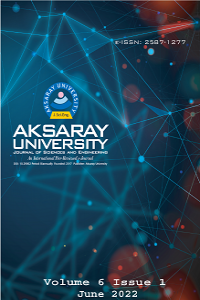Abstract
References
- [1] V. Divya, B. Agrawal, A. Srivastav, P. Bhatt, S. Bhowmik, K. Yadvendra Agrawal, P. Maity, Fluorescent amphiphilic silica nanopowder for developing latent fingerprints, Australian Journal of Forensic Sciences 52:3 (2018) 354-367.
- [2] L. Meng, Y. Ren, Z. Zhou, C. Li, C. Wang, S. Fu, Monodisperse silica nanoparticle suspension for developing latent blood fingermarks, Forensic Sciences Research 5:1 (2020) 38-46.
- [3] R. Rajan, Y. Zakaria, S. Shamsuddin, N.F.N. Hassan, Fluorescent variant of silica nanoparticle powder synthesized from rice husk for latent fingerprint development, Egyptian Journal of Forensic Sciences 9 (2019) 50.
- [4] H. Salmaner, Suç Yeri İncelemesi, Elif Matbaacılık, Şanlıurfa, 2003.
- [5] M.F. Brown, Criminal Investigation Law and Practice, Copyright by Butterworth – Heinemann, Printed in the USA, 1998.
- [6] H.C. Lee, T.M.Palmbach, M. Miller, Henry Lee’s Crime Scene Handbook, Academic Press, San Diego, CA, 2001.
- [7] T.J. Fish, L.S. Miller, M.C. Braswell, E.W. Wallace, Crime Scene Investigation, 3rd Edition, Publisher'sTransferred to Taylor & Francis, 2014.
- [8] R.M. Garnerd, Crime Scene Photography: US Perspective, 2009.
- [9] E. Çetli, A. Çalışkan, F. Koç, V. Özkoçak, The Importance of Anthropological and Genetic Data in Forensic Photography and Image Analysis, Eurasian Art & Humanities Journal 11 (2019) 1-14.
- [10] H.C. Lee, E.M. Pagliaro, Forensic Evidence and Crime Scene Investigation, J. Forensic Investigation, 1:2 (2013) 5.
- [11] G.L. Thomas, The physics of fingerprints and their detection, J. Phys. E: Sci. Instrum. 11:8 (1978) 722-731.
- [12] M. Bayer, Olay Yeri İnceleme Kriminal Laboratuvar Analizleri, Songür Yayıncılık, Ankara, 2003.
- [13] X. Jiang, Fingerprint Classification. In: Li S.Z., Jain A. (eds), Encyclopedia of Biometrics, Springer, Boston, MA, 2009.
- [14] K. Karu, A.K. Jain, Fingerprint Classification, Pattern Recognition 29:3 (1996) 389-404.
- [15] D. Meuwly, Fingerprint, Forensic Evidence of. In: Li S.Z., Jain A. (eds), Encyclopedia of Biometrics, Springer, Boston, MA, 2009.
- [16] L. Hong and A. K. Jain, Classification of fingerprint images, MSU Technical Report, MSUCPS:TR98-18, June 1998.
- [17] M.Z. Hacımurtazaoğlu, Ninhidrin Gözenekli Yüzeylerde Vücut İzi Tayininde Kullanılması ve Gözenekli Yüzeylerde Uygulanan Süper Glu Yöntemi ile Oluşan Vücut İzlerinin ANT ile Boyanarak Görünür Hale Getirilmesi. Recep Tayyip Erdoğan Üniversitesi Fen Bilimleri Enstitüsü Kimya ABD, Yüksek Lisans Tezi. Rize, 2016
- [18] M. Kaygısız, Kriminalistikte Parmak İzi İncelemesi, İstanbul Üniversitesi Adli Tıp Enstitüsü Fen Bilimleri ABD, Yüksek Lisans Tezi, İstanbul, 1995.
- [19] E. Tezbaşaran, Ninhidrinin Bazı Aromatik Aminlerle Olan Reaksiyonlarının Ft-Ir Sıvı Hücresinde İncelenmesi, Balıkesir Üniversitesi Fen Bilimleri Enstitüsü Kimya Anabilim Dalı, Yüksek Lisans Tezi. Balıkesir, 2011.
- [20] J. Almog and H. Glasner, Ninhydrin Thiohemiketals: Basic Research Towards Improved Fingermark Detection Techniques Employing Nano-Technology, J. Forensic Sci. 55:1 (2010) 215-220.
- [21] A. Lewkowicz, K. Baranowska, P. Bojarski, M. Jozefowicz, Solvent-dependent spectroscopic properties of fingerprint reagent - 1,8- Diazafluoren-9-one, Journal of Molecular Liquids 285 (2019) 754-765.
- [22] H.J. Kobus, R.N. Warrener, M. Stoilovic, Two Simple Staining Procedures which Improve the Contrast and Ridge Detail of Fingerprints Developed with “Super Glue” (Cyanoacrylate Ester), Forensic Science International 23 (1983) 233-240.
- [23] G.S. Bumbrah, Cyanoacrylate fuming method for detection of latent fingermarks: a review, Egyptian Journal of Forensic Sciences 7:4 (2017) 2-8.
- [24] M. Sorbiun, E.S. Mehr, A. Ramazani, S.T. Fardood, Green Synthesis of Zinc Oxide and Copper Oxide Nanoparticles Using Aqueous Extract of Oak Fruit Hull (Jaft) and Comparing Their Photocatalytic Degradation of Basic Violet 3, Int. J. Environ. Res. 12:1 (2018) 29-37.
- [25] S. Yeshodamma, D.V. Sunitha, R.B. Basavaraj, G.P. Darshan, B.D. Prasad, B.D., H.J. Nagabhushana, Monovalent ions co-doped SrTiO3:Pr3+ nanostructures for the visualization of latent fingerprints and can be red component for solid state devices, J. Lumin. 208 (2019) 371-387.
- [26] A. Mobaraki, Z. Hosseinzadeh, I. Yavari, Lipophilic magnetic nanocomposite of Fe3O4@SiO2@Me for efficient visualization of latent fingerprints on various surfaces, J. Iran Chem. Soc. 16:8 (2019) 1601-1610.
- [27] A. Askerbay, A. Molkenova, T.S. Atabaev, Latent fingerprint detection with luminescent Y2O3:Eu3+ nanoparticles, Materials Today: Proceedings 20 (2020) 245-248.
- [28] Y. Yang, R. Liu, Q. Cui,W. Xu, R. Peng, J. Wang, L. Li, Red-emissive conjugated oligomer/silica hybrid nanoparticles with high affinity and application for latent fingerprint detection, Colloids and Surfaces A 565 (2019) 118-130.
- [29] M. Tang, B. Zhu, Y. Qu, Z. Jin, S. Bai, F. Chai, L. Chen, C. Wang, F. Qu, Fluorescent silicon nanoparticles as dually emissive probes for copper(II) and visualization of latent fingerprints, Microchimica Acta 187 (2020) 65.
- [30] E. Alsolmy, W. M. Abdelwahab, G. Patonay, A Comparative Study of Fluorescein Isothiocyanate-Encapsulated Silica Nanoparticles Prepared in Seven Different Routes for Developing Fingerprints on Non-Porous Surfaces, Journal of Fluorescence 28 (2018) 1049-1058.
The Role of Silica Nanoparticle in Fingerprint Visualization Studies
Abstract
Fingerprints are the most important evidence that allows the criminal to be profiled in a crime scene investigation. A fingerprint is considered evidence due to its unique characteristics. Fingerprints are not visible and therefore need to be visualized after being recovered from the scene. Many methods are used for visualization purposes. The most commonly used methods are dusting, Ninhydrin, DFO, Super Glue, etc. the methods are not. In addition to these methods, other chemicals, physical and optical methods have recently been uncovered. Due to technological developments affecting the field of Forensic Sciences, new dimensions have also been introduced to fingerprint studies. The use of nanoparticles has gained momentum, especially in fingerprint visualization studies. In the use of nanoparticles, silica nanoparticles are used in studies.
Objective: this study, it was aimed to determine the level of use of silica nanoparticles in fingerprint visualization studies. Based on the data obtained for this purpose, which silica nanoparticle is most used, which method is most used in silica nanoparticle synthesis, what are the dimensions of the resulting molecules, which technique is most preferred for visualization, etc. it is aimed to provide researchers with up-to-date information by determining the parameters?
Method: In this study, the systematic literature review was preferred to collect research data. The level of use of silica nanoparticles has been investigated in fingerprint visualization studies between 2016 and 2020. Data collection was obtained through scientific studies. Parameters such as silica nanoparticle molecules, synthesis methods, absorbent values, surface types used, imaging types were compared in the obtained publications.
Supporting Institution
This study was produced from the master's thesis of the corresponding author.
References
- [1] V. Divya, B. Agrawal, A. Srivastav, P. Bhatt, S. Bhowmik, K. Yadvendra Agrawal, P. Maity, Fluorescent amphiphilic silica nanopowder for developing latent fingerprints, Australian Journal of Forensic Sciences 52:3 (2018) 354-367.
- [2] L. Meng, Y. Ren, Z. Zhou, C. Li, C. Wang, S. Fu, Monodisperse silica nanoparticle suspension for developing latent blood fingermarks, Forensic Sciences Research 5:1 (2020) 38-46.
- [3] R. Rajan, Y. Zakaria, S. Shamsuddin, N.F.N. Hassan, Fluorescent variant of silica nanoparticle powder synthesized from rice husk for latent fingerprint development, Egyptian Journal of Forensic Sciences 9 (2019) 50.
- [4] H. Salmaner, Suç Yeri İncelemesi, Elif Matbaacılık, Şanlıurfa, 2003.
- [5] M.F. Brown, Criminal Investigation Law and Practice, Copyright by Butterworth – Heinemann, Printed in the USA, 1998.
- [6] H.C. Lee, T.M.Palmbach, M. Miller, Henry Lee’s Crime Scene Handbook, Academic Press, San Diego, CA, 2001.
- [7] T.J. Fish, L.S. Miller, M.C. Braswell, E.W. Wallace, Crime Scene Investigation, 3rd Edition, Publisher'sTransferred to Taylor & Francis, 2014.
- [8] R.M. Garnerd, Crime Scene Photography: US Perspective, 2009.
- [9] E. Çetli, A. Çalışkan, F. Koç, V. Özkoçak, The Importance of Anthropological and Genetic Data in Forensic Photography and Image Analysis, Eurasian Art & Humanities Journal 11 (2019) 1-14.
- [10] H.C. Lee, E.M. Pagliaro, Forensic Evidence and Crime Scene Investigation, J. Forensic Investigation, 1:2 (2013) 5.
- [11] G.L. Thomas, The physics of fingerprints and their detection, J. Phys. E: Sci. Instrum. 11:8 (1978) 722-731.
- [12] M. Bayer, Olay Yeri İnceleme Kriminal Laboratuvar Analizleri, Songür Yayıncılık, Ankara, 2003.
- [13] X. Jiang, Fingerprint Classification. In: Li S.Z., Jain A. (eds), Encyclopedia of Biometrics, Springer, Boston, MA, 2009.
- [14] K. Karu, A.K. Jain, Fingerprint Classification, Pattern Recognition 29:3 (1996) 389-404.
- [15] D. Meuwly, Fingerprint, Forensic Evidence of. In: Li S.Z., Jain A. (eds), Encyclopedia of Biometrics, Springer, Boston, MA, 2009.
- [16] L. Hong and A. K. Jain, Classification of fingerprint images, MSU Technical Report, MSUCPS:TR98-18, June 1998.
- [17] M.Z. Hacımurtazaoğlu, Ninhidrin Gözenekli Yüzeylerde Vücut İzi Tayininde Kullanılması ve Gözenekli Yüzeylerde Uygulanan Süper Glu Yöntemi ile Oluşan Vücut İzlerinin ANT ile Boyanarak Görünür Hale Getirilmesi. Recep Tayyip Erdoğan Üniversitesi Fen Bilimleri Enstitüsü Kimya ABD, Yüksek Lisans Tezi. Rize, 2016
- [18] M. Kaygısız, Kriminalistikte Parmak İzi İncelemesi, İstanbul Üniversitesi Adli Tıp Enstitüsü Fen Bilimleri ABD, Yüksek Lisans Tezi, İstanbul, 1995.
- [19] E. Tezbaşaran, Ninhidrinin Bazı Aromatik Aminlerle Olan Reaksiyonlarının Ft-Ir Sıvı Hücresinde İncelenmesi, Balıkesir Üniversitesi Fen Bilimleri Enstitüsü Kimya Anabilim Dalı, Yüksek Lisans Tezi. Balıkesir, 2011.
- [20] J. Almog and H. Glasner, Ninhydrin Thiohemiketals: Basic Research Towards Improved Fingermark Detection Techniques Employing Nano-Technology, J. Forensic Sci. 55:1 (2010) 215-220.
- [21] A. Lewkowicz, K. Baranowska, P. Bojarski, M. Jozefowicz, Solvent-dependent spectroscopic properties of fingerprint reagent - 1,8- Diazafluoren-9-one, Journal of Molecular Liquids 285 (2019) 754-765.
- [22] H.J. Kobus, R.N. Warrener, M. Stoilovic, Two Simple Staining Procedures which Improve the Contrast and Ridge Detail of Fingerprints Developed with “Super Glue” (Cyanoacrylate Ester), Forensic Science International 23 (1983) 233-240.
- [23] G.S. Bumbrah, Cyanoacrylate fuming method for detection of latent fingermarks: a review, Egyptian Journal of Forensic Sciences 7:4 (2017) 2-8.
- [24] M. Sorbiun, E.S. Mehr, A. Ramazani, S.T. Fardood, Green Synthesis of Zinc Oxide and Copper Oxide Nanoparticles Using Aqueous Extract of Oak Fruit Hull (Jaft) and Comparing Their Photocatalytic Degradation of Basic Violet 3, Int. J. Environ. Res. 12:1 (2018) 29-37.
- [25] S. Yeshodamma, D.V. Sunitha, R.B. Basavaraj, G.P. Darshan, B.D. Prasad, B.D., H.J. Nagabhushana, Monovalent ions co-doped SrTiO3:Pr3+ nanostructures for the visualization of latent fingerprints and can be red component for solid state devices, J. Lumin. 208 (2019) 371-387.
- [26] A. Mobaraki, Z. Hosseinzadeh, I. Yavari, Lipophilic magnetic nanocomposite of Fe3O4@SiO2@Me for efficient visualization of latent fingerprints on various surfaces, J. Iran Chem. Soc. 16:8 (2019) 1601-1610.
- [27] A. Askerbay, A. Molkenova, T.S. Atabaev, Latent fingerprint detection with luminescent Y2O3:Eu3+ nanoparticles, Materials Today: Proceedings 20 (2020) 245-248.
- [28] Y. Yang, R. Liu, Q. Cui,W. Xu, R. Peng, J. Wang, L. Li, Red-emissive conjugated oligomer/silica hybrid nanoparticles with high affinity and application for latent fingerprint detection, Colloids and Surfaces A 565 (2019) 118-130.
- [29] M. Tang, B. Zhu, Y. Qu, Z. Jin, S. Bai, F. Chai, L. Chen, C. Wang, F. Qu, Fluorescent silicon nanoparticles as dually emissive probes for copper(II) and visualization of latent fingerprints, Microchimica Acta 187 (2020) 65.
- [30] E. Alsolmy, W. M. Abdelwahab, G. Patonay, A Comparative Study of Fluorescein Isothiocyanate-Encapsulated Silica Nanoparticles Prepared in Seven Different Routes for Developing Fingerprints on Non-Porous Surfaces, Journal of Fluorescence 28 (2018) 1049-1058.
Details
| Primary Language | English |
|---|---|
| Journal Section | Research Article |
| Authors | |
| Publication Date | June 30, 2022 |
| Submission Date | December 11, 2021 |
| Acceptance Date | March 24, 2022 |
| Published in Issue | Year 2022 Volume: 6 Issue: 1 |
Cited By
A Comparative Analysis of Traditional Latent Fingerprint Visualization Methods and Innovative Silica Gel G Powder Approach
Journal of Forensic Science and Research
https://doi.org/10.29328/journal.jfsr.1001063
Aksaray J. Sci. Eng. | e-ISSN: 2587-1277 | Period: Biannually | Founded: 2017 | Publisher: Aksaray University | https://asujse.aksaray.edu.tr
ASUJSE is indexing&Archiving in










